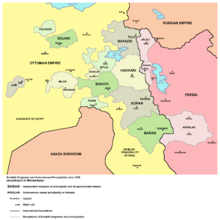Soran (Principality)

For comparison, today's limits |
Soran was a Kurdish emirate that mainly comprised the settlement area of the Kurds in what is now northern Iraq and existed for more than six centuries until it was conquered by the Ottoman Empire in 1835 after five years of independence .
history
The Scherefname of Şerefhan reports that the founder of the later principality was the Arab Abbasid Kelos from Baghdad . At that time, however, it was common in the Islamic world to trace the origin of a ruling dynasty back to an important Arab-Muslim family in order to gain prestige and legitimation. Isa, one of his many sons, succeeded him. He captured the fortress of Rawanduz . Sharaf Khan Bidlisi reported that the word Soran comes from the red bricks of the fortress in Rawanduz because Sor on German Red means and thus Soran the Red mean.
The area of the Soran bordered in the south on the Kurdish principality of the Baban , in the east on Persia , in the west and north on the principality Badinan and Erbil . It often had conflicts with the neighboring principalities. Most of the time, Rawanduz was the capital of the emirate. Before its declaration of independence, it was an autonomous emirate in Vilayet Shahrazor .
At the beginning of the 19th century the principality included the places Havdiyan, Shatan, Dolamani, Seydakan, Pirasani, Hakurk, Babischitiyan, Rawanduz, Akoyan and Balakan. To put it roughly, the principality consisted of the area between the Big and Small Zab .
Decay
At the beginning of the 19th century, the ruler Mîr Mohammed , also Mîre Kor ( The Blind Prince ) for short, rated the principality as powerful enough to force expansion. Mir Mohammed had several 10,000 soldiers and armories, in which he also had cannons produced. He was also known for his uncompromising character, including a. due to the fact that he had all of the contenders for the throne who were competing with him murdered. He first expanded north, conquered Badinan and marched on to Botan (today's Şırnak ). In 1830 he declared the independence of the principality from the Ottoman Empire and, as a sign of independence, a. Mint coins. At the beginning the Beylerbey recognized the Ottomans in Baghdad independence. But when he realized that Mir Mohammed wanted to keep expanding, the Ottomans went on the offensive and defeated him militarily. Mir Mohammed was called to Istanbul. On the return journey he was murdered by strangers near Trabzon. With him the principality ended and was added to the Beylerbey of Baghdad.
Use of the name Soran
The Central Kurdish , commonly known as Sorani, was named after this emirate. The current district Soran in the province of Erbil the Iraqi Kurdistan has also been named after it. Soran is also the name of a tribe that lives in Kirkuk.
Individual evidence
- ↑ Turkish translation of the Scheref name by Mehmed Emîn Bozarslan : Şerefname - Kürt tarihi ; Publisher: Hasat Yayınları; P. 303
- ↑ Turkish translation of the Scheref name by Mehmed Emîn Bozarslan : Şerefname - Kürt tarihi ; Publisher: Hasat Yayınları; P. 305
- ↑ Dr. Celile Celil: XIX. Yüzyıl Osmanlı İmperatorluğu'nda Kürtler ; Verlag Özge; P. 72

